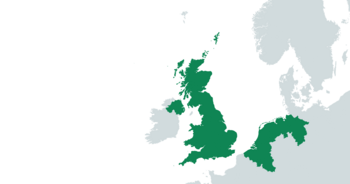Hanoverian Union: Difference between revisions
(Created page with "{{Infobox geopolitical organization |name = ''Hannoveraanse Unie'' ({{wp|Dutch}})<br/>''Union hanovrienne'' ({{wp|French}})<br/>''Hannoverescher Unioun'' ({{wp|Lu...") |
No edit summary |
||
| Line 78: | Line 78: | ||
The '''Hanoverian Union''' ({{wp|Dutch}}: ''Hannoveraanse Unie'' {{wp|French}}: ''Union hanovrienne'' {{wp|Luxembourgish}}: ''Hannoverescher Unioun'') is a politico-economic union consisting of three neighbouring countries in {{wp|Western Europe}}, namely the {{wp|United Kingdom}}, the {{wp|Netherlands}}, and {{wp|Luxembourg}}, all three of which are constitutional monarchies with a single {{wp|House of Hanover|Hanoverian}} monarch as their respective head of state, currently [[Alexandra of the United Kingdom and of the Netherlands|Queen/Grand Duchess Alexandra]]. Formed in 1946 as a result of the {{wp|Brussels Agreement}} between the governments of all three countries, the organisation mainly promotes intergovernmental cooperation between its three member states, with the reigning {{wp|House of Hanover|Hanoverian}} monarch being promoted and seen as a common and unifying identity between the three countries. With an estimated total population of 105 million, the union covers a total area of approximately 365,754.4 km2 (141,218.6 sq mi), which also includes the {{wp|English Channel}} separating the {{wp|United Kingdom}} from both the {{wp|Netherlands}} and {{wp|Luxembourg}} on the {{wp|European}} mainland. | The '''Hanoverian Union''' ({{wp|Dutch}}: ''Hannoveraanse Unie'' {{wp|French}}: ''Union hanovrienne'' {{wp|Luxembourgish}}: ''Hannoverescher Unioun'') is a politico-economic union consisting of three neighbouring countries in {{wp|Western Europe}}, namely the {{wp|United Kingdom}}, the {{wp|Netherlands}}, and {{wp|Luxembourg}}, all three of which are constitutional monarchies with a single {{wp|House of Hanover|Hanoverian}} monarch as their respective head of state, currently [[Alexandra of the United Kingdom and of the Netherlands|Queen/Grand Duchess Alexandra]]. Formed in 1946 as a result of the {{wp|Brussels Agreement}} between the governments of all three countries, the organisation mainly promotes intergovernmental cooperation between its three member states, with the reigning {{wp|House of Hanover|Hanoverian}} monarch being promoted and seen as a common and unifying identity between the three countries. With an estimated total population of 105 million, the union covers a total area of approximately 365,754.4 km2 (141,218.6 sq mi), which also includes the {{wp|English Channel}} separating the {{wp|United Kingdom}} from both the {{wp|Netherlands}} and {{wp|Luxembourg}} on the {{wp|European}} mainland. | ||
Unlike the {{wp|European Union}}, the Hanoverian Union does not have a single legislative body, hence its mostly loose nature. Nonetheless, the organisation is chaired by a chairman whom is assisted in their role by a deputy chairman. By convention, both offices rotate among the three member states every five years, with the office of chairman normally going to the chosen country's deputy prime minister, while the office of deputy chairman goes to the deputy prime minister, or in the case of {{wp|Luxembourg}}'s, deputy prime ministers, of the country next in line to the organisation's chairmanship. | Unlike the {{wp|European Union}}, the Hanoverian Union does not have a single legislative body, hence its mostly loose nature. Nonetheless, the organisation is chaired by a chairman whom is assisted in their role by a deputy chairman. By convention, both offices rotate among the three member states every five years, with the office of chairman normally going to the chosen country's deputy prime minister, while the office of deputy chairman goes to the deputy prime minister, or in the case of {{wp|Luxembourg}}'s, deputy prime ministers, of the country next in line to the organisation's chairmanship. The organisation's headquarters is located in {{wp|Brussels}}, although both its chairman and deputy chairman otherwise reside in their respective countries. | ||
Revision as of 09:21, 16 October 2022
Hanoverian Union | |
|---|---|
|
Flag | |
| Motto: "Eenheid onder de kroon" (Dutch) "L'unité sous la couronne" (French) "Eenheet ënner der Kroun" (Luxembourgish) "Unity Under The Crown" | |
 | |
| Administrative center | Brussels |
| Other languages | English, Dutch, French, Luxembourgish |
| Leaders | |
• Chairman | Wopke Hoekstra |
| François Bausch Paulette Lenert | |
| Establishment | |
| 6 December 1946 | |
| Area | |
• | 365,754.4 km2 (141,218.6 sq mi) |
| Population | |
• 2021 estimate | 105,594,693 |
| GDP (PPP) | 2021 estimate |
• Total | $6.005 trillion |
• Per capita | $56,870 |
| GDP (nominal) | 2021 estimate |
• Total | $5.305 trillion |
• Per capita | $50,246 |
| HDI (2021) | 0.934 very high |
The Hanoverian Union (Dutch: Hannoveraanse Unie French: Union hanovrienne Luxembourgish: Hannoverescher Unioun) is a politico-economic union consisting of three neighbouring countries in Western Europe, namely the United Kingdom, the Netherlands, and Luxembourg, all three of which are constitutional monarchies with a single Hanoverian monarch as their respective head of state, currently Queen/Grand Duchess Alexandra. Formed in 1946 as a result of the Brussels Agreement between the governments of all three countries, the organisation mainly promotes intergovernmental cooperation between its three member states, with the reigning Hanoverian monarch being promoted and seen as a common and unifying identity between the three countries. With an estimated total population of 105 million, the union covers a total area of approximately 365,754.4 km2 (141,218.6 sq mi), which also includes the English Channel separating the United Kingdom from both the Netherlands and Luxembourg on the European mainland.
Unlike the European Union, the Hanoverian Union does not have a single legislative body, hence its mostly loose nature. Nonetheless, the organisation is chaired by a chairman whom is assisted in their role by a deputy chairman. By convention, both offices rotate among the three member states every five years, with the office of chairman normally going to the chosen country's deputy prime minister, while the office of deputy chairman goes to the deputy prime minister, or in the case of Luxembourg's, deputy prime ministers, of the country next in line to the organisation's chairmanship. The organisation's headquarters is located in Brussels, although both its chairman and deputy chairman otherwise reside in their respective countries.
